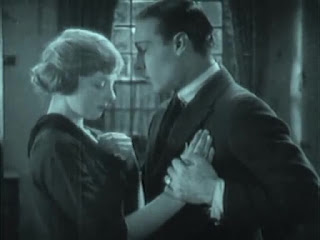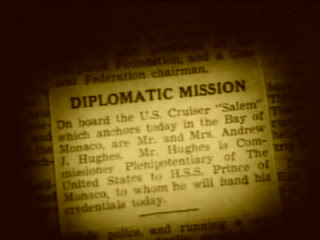This film has a historical importance because, to this date, it is the earliest-surviving film directed by Mabel Normand. She was 21 years old at the time and was at the height of her beauty and vitality. Previously thought to be a lost film, it was discovered in 2010 in New Zealand.
The 1910s comedies by Keystone studios show us that it is possible to be funny with simple resources. They were mainly one or two reelers with very simple plots and the gags were the center of all action. In addition to frantic chases, quick pace, fake facial hair and occasional broad gestures, an important component in those comedies was misunderstanding. And this is exactly what we will see in this film.
A woman is sweeping the floor outside a house and a man with a big sheriff badge approaches her. Then, there’s an intertitle saying: “Dreaming of her ideal” and we see Mabel sitting down outdoors. Two men are shown, one of them approaches Mabel. She does not care very much and leave and walk towards a river and the other man laugh at the man who was rejected.
It is shown once more the woman who was sweeping the floor and the sheriff. The woman enter the house leaving the man outside speaking a lot.
The two men are shown again. The other man try her lucky in approaching Mabel while the rejected man look at it from a distance. This other man end up being rejected by Mabel just like the previous one.
The sheriff return to the police department, the other policemen are idle and the sheriff complain about it.
Now Mabel is in a sort of forest and both men are still all around her. There is an intertitle: “Her ideal” and we see another man and it is shown to the audiences that they really liked each other, to the disgust of the two men who were interested in Mabel previously in the film. At this point of the film, there is a split screen with both love interests walking towards each other, which create a very beautiful and innocent event. Mabel’s love interest give a fruit to her and she accept it with joy.
On the following scene it is shown the sheriff once more visiting the woman who was out of her house and the audiences can see that there is mutual romantic interest between them.
Both of Mabel’s previous suitors approach the couple, but Mabel refuse to speak to them. The men started to bully Mabel’s love interest and she get angry. A fight take place and everyone start throwing things at each other. The sheriff appear by chance in the middle of the chaos and was hit by accident too. The sheriff beat up Mabel’s suitor and took her away.
It is shown the intertitle: “Mother’s pet”. Mabel’s love interest return home, which is the same house where the woman sweeping the floor live and it become clear that he is her son and a kind of coward person. It is also clear that Mabel is the sheriff’s daughter. Both Mabel and her suitor were admonished by their parents at homed due to the fighting they were involved.
But Mabel’s love interest did not give up and he showed up at her house. Mabel talked to him by the window and meet him outside. Meanwhile, the sheriff was visiting his love interest and at this point it become clear to the audiences that the parents of Mabel and her suitor were having an affair. The boy’s mother enter a cupboard within her house, the sheriff enter the house and does not see her.
Mabel and her suitor meet a tramp while they are walking outdoors. Right afterwards, the couple was passing nearby the boy’s house and he invite Mabel to go inside. The problem is that the sheriff was already within the house and in order to avoid being seen by the couple, the sheriff decided to hide inside a cupboard, the same place where the woman (his sweetheart, the owner of the house and the boy’s mother) was also hiding. Both people realize that their children were outside and got nervous in fear of a scandal if their children found out about their affair.
Mabel and her sweetheart enter the boy’s home and Mabel see that there is somebody inside the cupboard and she think that the tramp they have met on the street a short time ago was the one who was hiding in the cupboard. The boy go outside and cry for help and meanwhile Mabel barricade the cupboard’s door. Many people in the neighborhood go to the house to help them get rid of the so-called tramp and Mabel also called the police department.
Chaos ensue as many people go to the boy’s house at the same time, including the policemen and the neighbors carrying rifles. The cupboard is removed from the house and people try to open it in whatever way they can. Of course that after all effort the cupboard’s door was eventually open and everyone knew who was inside. It turned out that the scandal and gossip could not be avoided.
Won in a Cupboard was categorized as a nonsense number by Moving Picture World in 1914 and I have to say this is an average comedy of the era, but it remain worth seeing. It is a nice example of Mabel’s directorial style. She had her own production unit in Keystone studios at the time and it would last for around one year and, during this time, she directed all films of that unit. This film is also a precious witness of a country life that has been gone a long time ago. It’s a joy that the film was recovered after so many years.


































